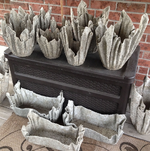Dirtmechanic
Active member
- Hardiness zone
- 8a
This will be the year I find time to make raised beds and hypertufa pots I promise. I know I have some other cement and mortar projects that are very useful in requiring extra materials that can find their way into the garden setting. But I haz questions.
How much portland in a cement mix like hypertufa? Is adding lime like a mortar a good idea, or is the size of the sand if any used best? Is the sand sieve size a particular number?
How much portland in a cement mix like hypertufa? Is adding lime like a mortar a good idea, or is the size of the sand if any used best? Is the sand sieve size a particular number?
Last edited:

